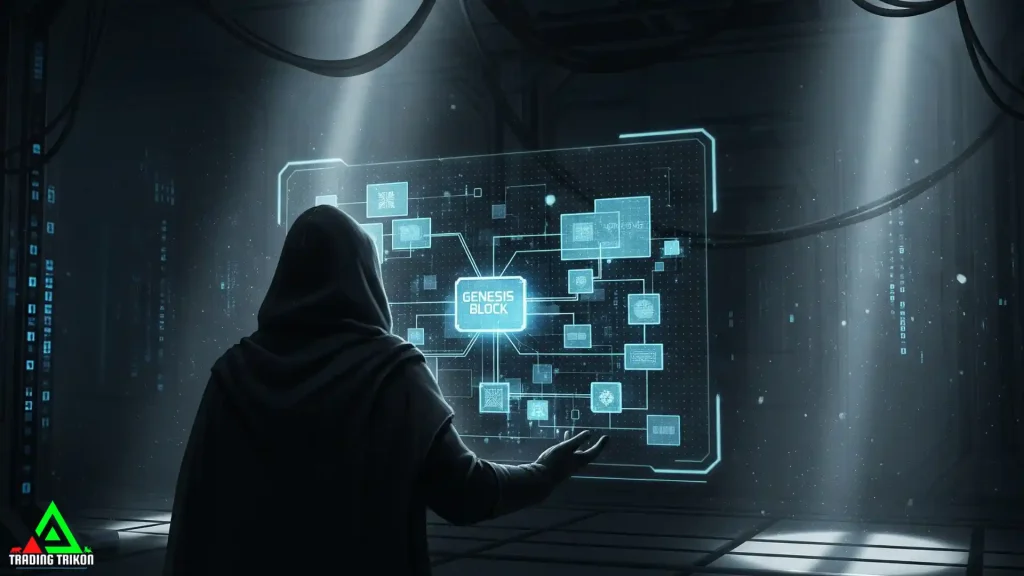Imagine a single line of code sparking a financial revolution worth trillions. That’s the story of Bitcoin’s Genesis Block—the very foundation of the world’s first cryptocurrency. Mined in the shadows of the 2008 financial crisis, this enigmatic block not only launched a new era of digital money but also hid secrets that continue to intrigue experts and enthusiasts alike. In this deep dive, we’ll explore what the Genesis Block really is, the puzzles it presents, and the cryptic message embedded within it. Whether you’re a crypto novice or a seasoned trader, prepare to uncover the origins of Bitcoin like never before.
What Is the Genesis Block? A Simple Definition

At its core, the Genesis Block is the inaugural block in a blockchain network. For Bitcoin, it’s Block 0—the starting point from which every subsequent transaction and block builds upon. Created on January 3, 2009, by the pseudonymous inventor Satoshi Nakamoto, this block marks the birth of decentralized finance.
Unlike regular blocks that record multiple transactions, the Genesis Block is unique. It contains the first-ever Bitcoin transaction, known as the coinbase transaction, which rewarded Satoshi with 50 Bitcoins. However, these coins are unspendable due to a deliberate design quirk in the code, adding an layer of intrigue right from the start.
Think of it as the cornerstone of a massive digital ledger. Every Bitcoin transaction since—now numbering in the billions—traces back to this one block. It’s hardcoded into Bitcoin’s software, ensuring that all nodes in the network agree on the chain’s history. Without it, the entire blockchain wouldn’t exist.
The Birth of Bitcoin’s Blockchain: How It All Began
The Genesis Block didn’t emerge in a vacuum. It was born amid the chaos of the global financial meltdown. Satoshi Nakamoto, whose true identity remains one of the greatest unsolved mysteries in tech, released the Bitcoin whitepaper in October 2008. Titled “Bitcoin: A Peer-to-Peer Electronic Cash System,” it outlined a vision for money free from banks and governments.
Just months later, on January 3, 2009, Satoshi mined the Genesis Block using a standard computer—nothing like today’s massive mining rigs. The block’s hash, a unique digital fingerprint, is 000000000019d6689c085ae165831e934ff763ae46a2a6c172b3f1b60a8ce26f. This string of characters verifies its authenticity and prevents tampering.
What makes this block revolutionary? It introduced proof-of-work, the consensus mechanism that secures the network. Miners compete to solve complex puzzles, adding new blocks and validating transactions. The Genesis Block set the difficulty level and established rules like the 21 million Bitcoin supply cap, creating scarcity that drives value.
Fast-forward to today: Bitcoin’s blockchain has grown to over 800,000 blocks, processing billions in daily transactions. Yet, it all loops back to that first block, proving the system’s resilience over 16 years.
The Secret Message: A Hidden Critique of the Financial System
Buried in the Genesis Block’s coinbase data is a headline from The Times newspaper: “The Times 03/Jan/2009 Chancellor on brink of second bailout for banks.” This isn’t random—it’s a deliberate timestamp and a sharp jab at traditional finance.
Satoshi included this message to prove the block wasn’t pre-mined before the official launch, ensuring fairness. But it goes deeper. The 2008 crisis exposed flaws in centralized banking: bailouts for the elite while ordinary people suffered. Satoshi’s note symbolizes Bitcoin’s mission—to create a trustless system where individuals control their wealth.
This easter egg has inspired countless theories. Was it a political statement? A call to arms against inflation and corruption? Whatever the intent, it resonates today as Bitcoin surges past $100,000 per coin in volatile markets, reminding us of its anti-establishment roots.
Mysteries Surrounding the Genesis Block

The Genesis Block isn’t just history; it’s a riddle wrapped in code. Here are some of the most captivating puzzles:
The Identity of Satoshi Nakamoto
Who mined the first block? Satoshi vanished in 2011, leaving behind a fortune in untouched Bitcoins. Speculation ranges from cryptographers like Hal Finney to tech moguls, but no concrete proof exists. This anonymity fuels Bitcoin’s mystique, turning it into a leaderless movement.
The Unspendable 50 Bitcoins
Why can’t those initial coins be moved? It’s due to a coding anomaly in the coinbase transaction. Some theorize it was intentional, symbolizing sacrifice for the greater good. Others see it as a bug Satoshi overlooked. Either way, they’re locked forever, worth over $5 million at current prices.
The Five-Day Mining Gap
A lesser-known enigma: After mining the Genesis Block on January 3, 2009, the next block (Block 1) wasn’t added until January 9— a six-day wait (often rounded to five in discussions). Why the delay? Theories include Satoshi testing the network solo, adjusting difficulty, or even a symbolic pause. Recent analyses suggest it was to iron out bugs, but the exact reason remains elusive, adding to the lore of Bitcoin’s early days.
Hidden Codes and Easter Eggs
Beyond the headline, enthusiasts have scoured the block for more secrets. Hex dumps reveal no other messages, but the block’s structure hints at Satoshi’s meticulous planning. Some believe it contains subtle nods to cypherpunk ideals, the privacy-focused movement that birthed crypto.
These mysteries keep the community buzzing, with forums and podcasts dissecting every byte. As Bitcoin evolves, new tools might unlock more clues, but for now, they enhance its legendary status.
Why the Genesis Block Matters in Today’s Crypto World
In an age of NFTs, DeFi, and spot Bitcoin ETFs, the Genesis Block feels ancient. Yet, its principles endure. It underscores blockchain’s immutability—once added, data can’t be altered, fostering trust in a digital age.
For investors, understanding this origin story highlights Bitcoin’s value as “digital gold.” Amid economic uncertainty, from inflation to geopolitical tensions, it serves as a hedge, much like Satoshi envisioned.
Looking ahead, as blockchain tech expands into Web3 and beyond, the Genesis Block reminds us of innovation’s power. It’s not just code; it’s a blueprint for financial freedom.
Final Thoughts: Dive Deeper into Bitcoin’s Legacy

The Genesis Block isn’t merely the start of Bitcoin—it’s a testament to human ingenuity and rebellion. From its definition as blockchain’s foundation to the mysteries and secret message that captivate us, it continues to shape the crypto landscape. If you’re inspired to explore more, consider wallet setups or market trends. What’s your take on Satoshi’s message? Share in the comments below—we’d love to hear your theories!
What is Bitcoin’s Genesis Block?
Bitcoin’s genesis block is the very first block of transactions in the Bitcoin blockchain, mined by Satoshi Nakamoto on January 3, 2009. It’s the foundational block, or Block 0, from which the entire chain of subsequent blocks originates. Unlike other blocks, it has no predecessor, and its reward of 50 bitcoins is unspendable due to a unique coding quirk.
What message is hidden in the Genesis Block?
The genesis block contains a hidden message in its coinbase parameter: “The Times 03/Jan/2009 Chancellor on brink of second bailout for banks.” This phrase is a headline from a British newspaper, The Times, from the day the block was mined. It serves as both a timestamp and a philosophical statement on the financial crisis.
How many bitcoins are in the Genesis Block?
The genesis block contains a mining reward of 50 bitcoins. However, these specific bitcoins are permanently locked and cannot be spent or transferred. This makes the block a historical artifact rather than a source of usable currency.
What makes the Genesis Block so special?
The genesis block is special because it’s the anchor point for the entire Bitcoin network. It established the core rules of the blockchain, including the 50 BTC reward, and contains Satoshi Nakamoto’s cryptic message. Its immutability and the unspent coins within it contribute to its legendary status as the symbolic birth of cryptocurrency.



